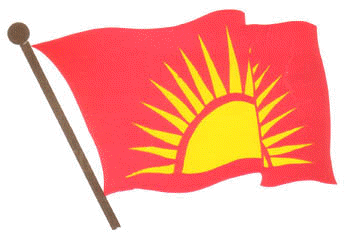
JVP leader with
H.L.de Silva P.C., Counsel for the
Petitioners garlanded after
the Verdict
COLOMBO: The Bench of
five Supreme Court Judges yesterday
held that the Proclamation made by
the then President J.R. Jayewardene
merging the North and East provinces
as one administrative province had
no force in law.
The Court delivering the judgement
in three Fundamental Rights
applications filed by the JVP held
that the two mandatory conditions
that led to the Proclamation had not
been satisfied.
"The Proclamation made by the then President declaring that the Northern and Eastern Provinces shall form one administrative unit has been made when neither of the conditions specified in the Section 37 (1)(b) of the Provincial Councils Act No. 42 of 1987 as to the surrender of weapons and the cessation of hostilities, were satisfied. Therefore, the order must necessarily be declared invalid since it infringes the limits which Parliament itself had ordered."
The Court also held
that the Emergency Regulations under
which the then President made the
purported Amendment to the
Provincial Councils Act leading to
the Proclamation was ultravirus and
in excess of the powers of the
President.
The Bench comprised Chief Justice
Sarath N. Silva PC and Justices
Nihal Jayasinghe, N.K. Udalagama,
Raja Fernando and Nimal Gamini
Amaratunga.
Petitioners JVP MP Jayanatha
Wijesekera, A.S.M. Buhari and L.P.
Wasantha in their petitions stated
that their right to equality had
been violated by the failure of the
President to set a date for the
establishment of a separate
Provincial Council for the Eastern
Province and the consequential
failure to afford the petitioners as
well as other inhabitants an
opportunity to exercise their right
to vote at an election for
membership of such council.
The petitioners sought two persons
to be appointed by the President as
Governors of the Northern Province
and the Eastern Province.
They also sought declarations that
the proclamation made by the then
President published in the gazette
dated September 8, 1988 merging the
North and East provinces into a
single unit of administration and
the Emergency Regulations declared
on September 2, 1988 were null and
void without having any legal
effect.
The petitioners, voters of the
Eastern Province cited the Attorney
General, the Governor of the
North-East Provincial Council and
the Commissioner of Elections as
respondents.
They stated that the merger was
illegal since the Section 37(1) of
the Provincial Councils Act No. 42
of 1987 was not validly amended.
They contended that the purported
amalgamation was invalid and the two
provinces remained as two separate
administrative units.
H.L. de Silva PC with S.L.
Gunasekera, Gomin Dayasiri and
Manoli Jinadasa instructed by Paul
Ratnayake Associates appeared for
the Petitioners.
Additional Solicitor General P.A.
Ratnayake PC with Deputy Solicitor
Generals Anil Gunaratne and A.
Gnanathasan, Senior State Counsel
Indika Demuni de Silva, Janak de
Silva, Milinda Gunathilake, and
Nerin Pulle appeared for the
respondents. Kanag-Isawaran PC with
M.A. Sumanthiran and Batty Weerakoon
with Percy Wickramasekera appeared
for the Intervenient petitioners.
Meanwhile, when contacted by the
Daily News President's Counsel H. L.
de Silva the senior council for the
petitioners said the Elections
Commissioner who had been a
respondent to the three rights cases
should take steps to hold elections
for the two Provincial Councils, the
North and the East separately.
"In order to do so the Commissioner
should first assess whether the
situation is conducive to hold an
election." President's
Counsel Silva also told that the
question of a referendum would not
arise since there was not a valid
merger.
The spokesman for the President's
Secretariat said that the Government
would make a careful study of the
determination by the Supreme Court
with all its implications in
deciding on steps to be taken in
view of the determination.


